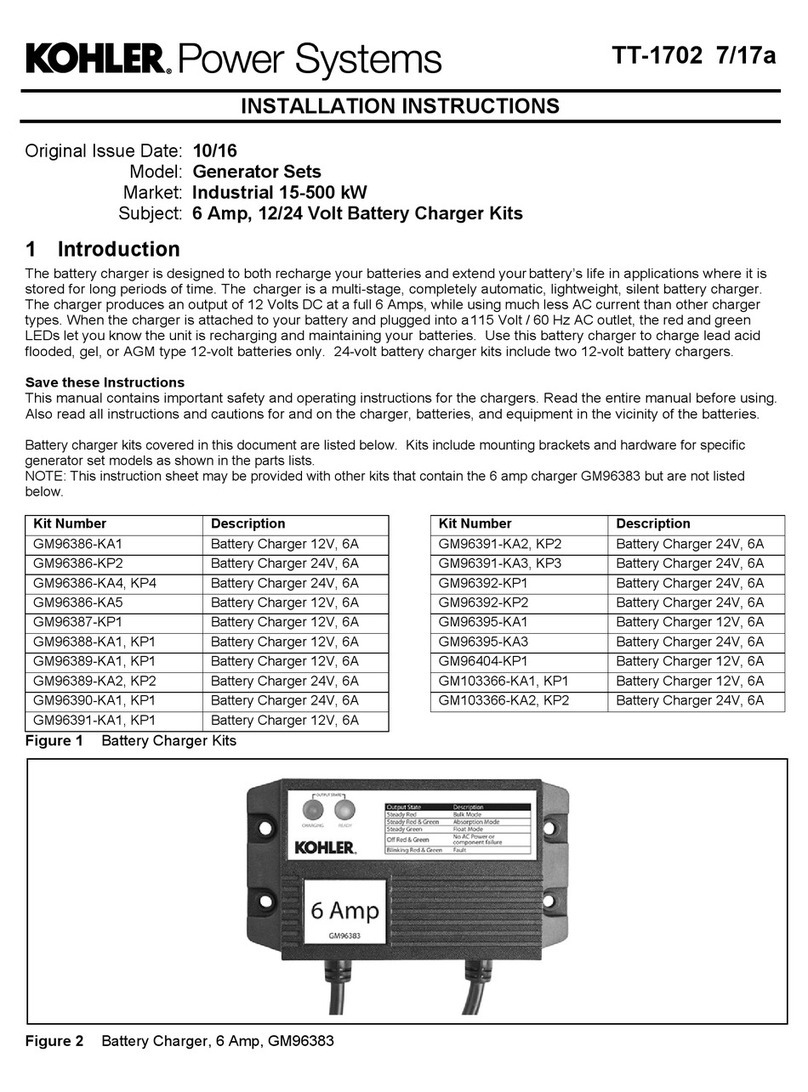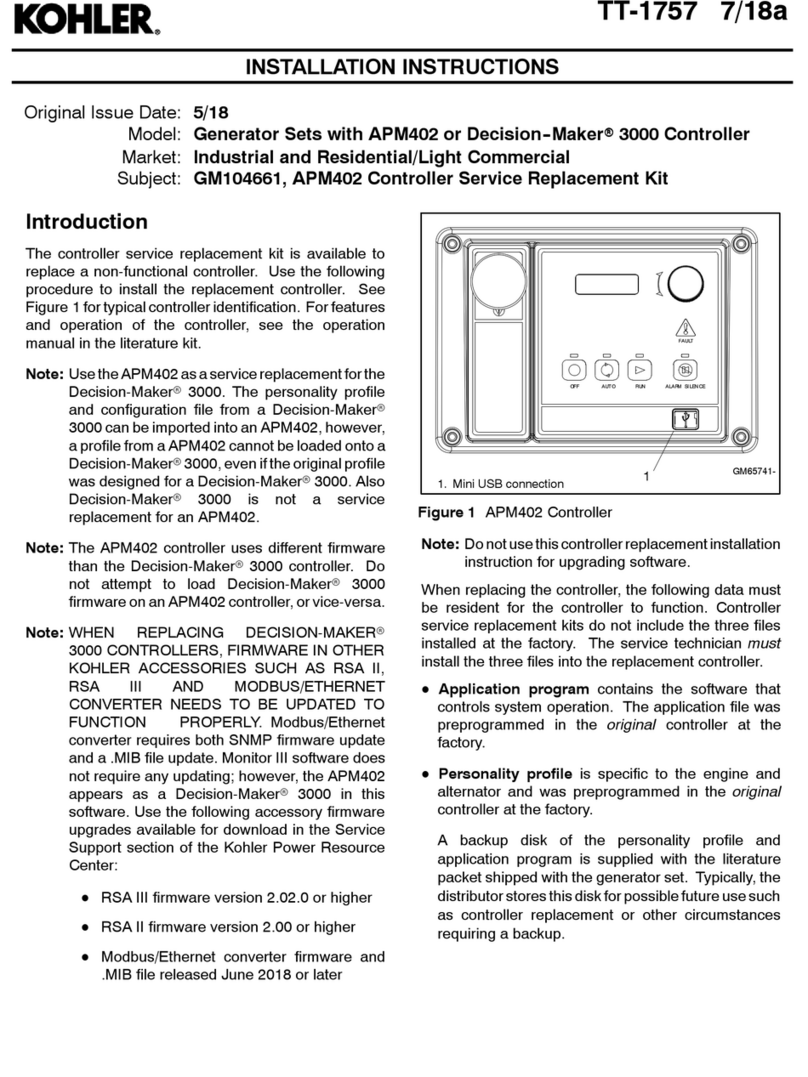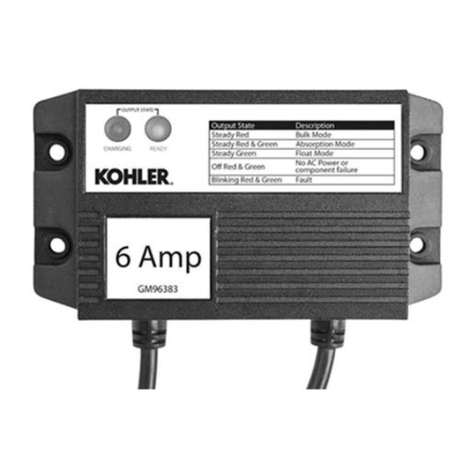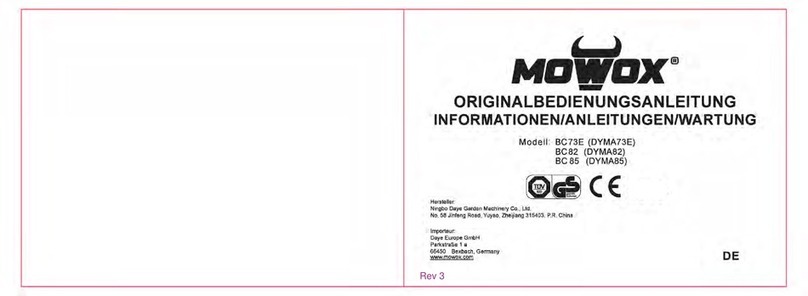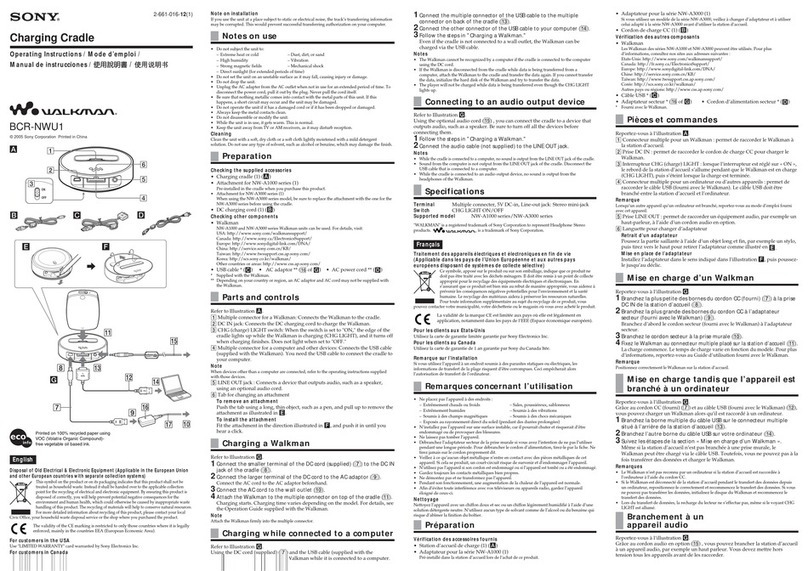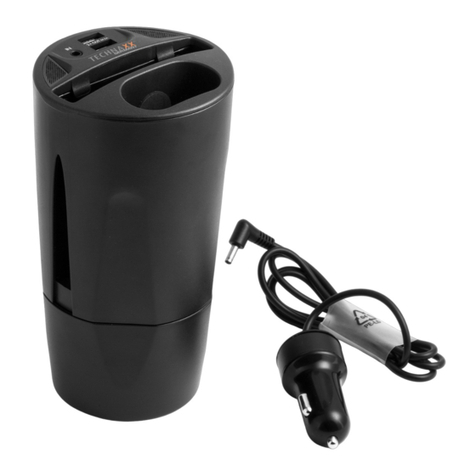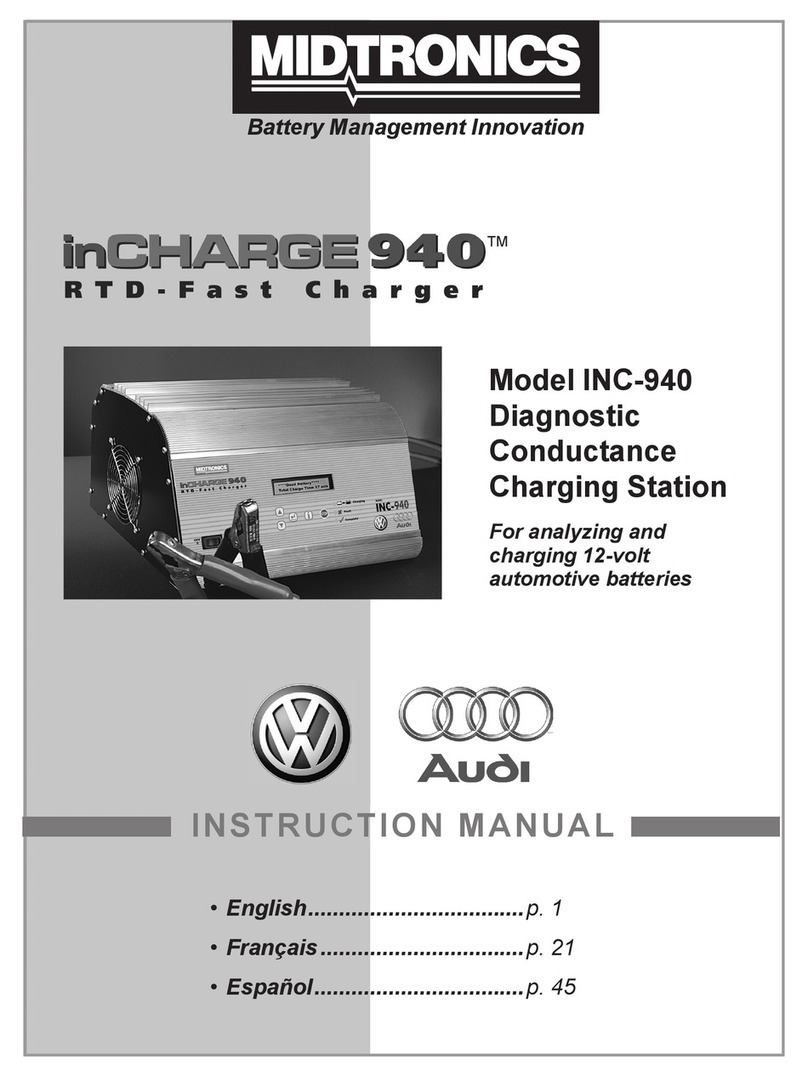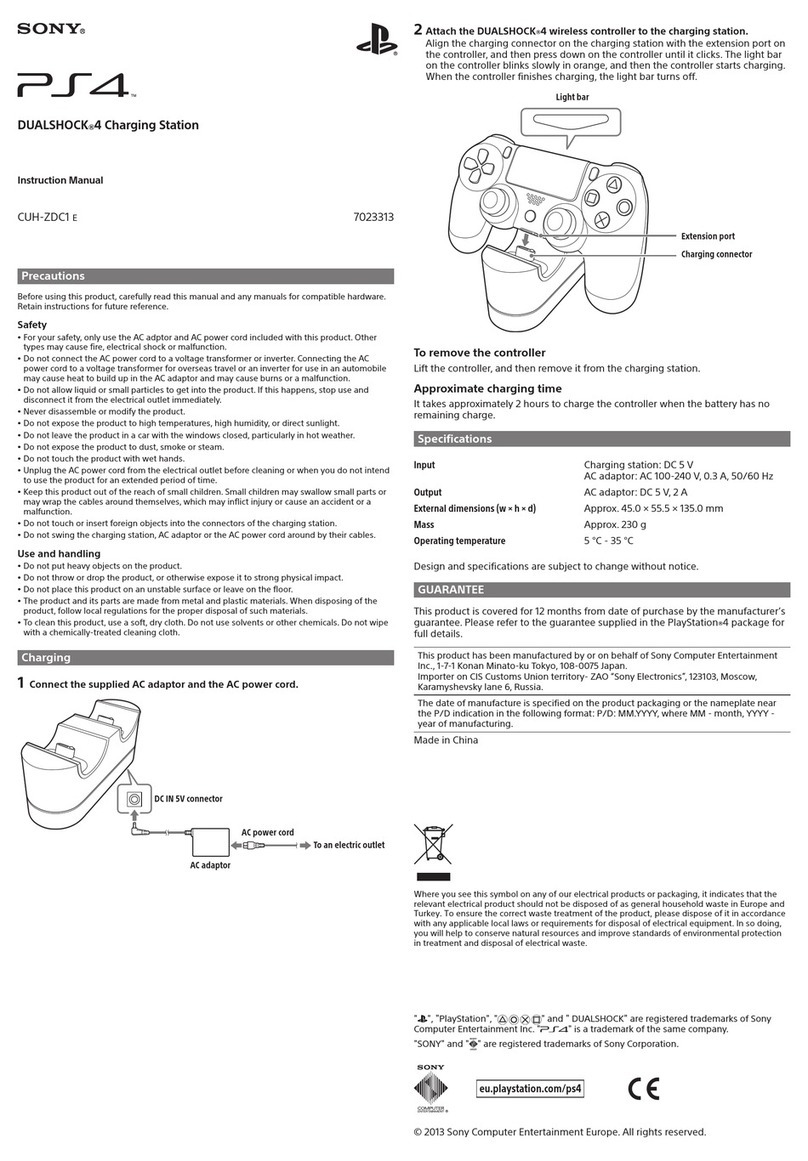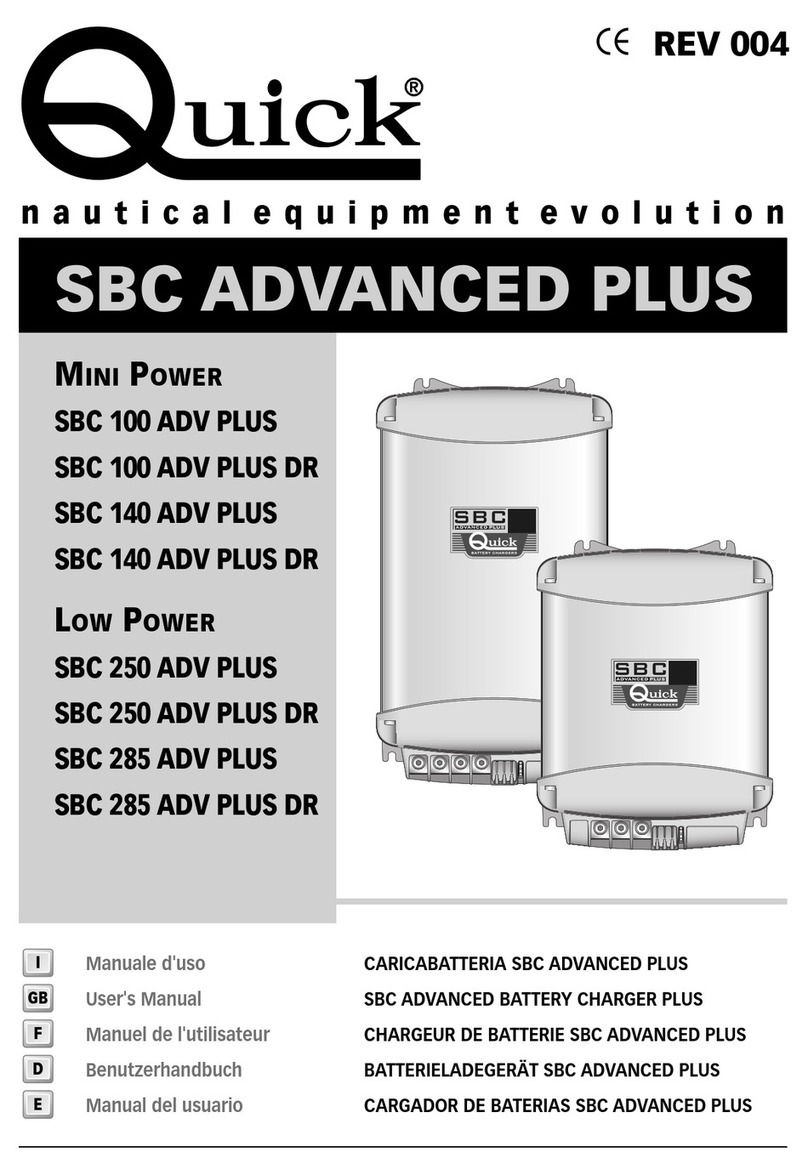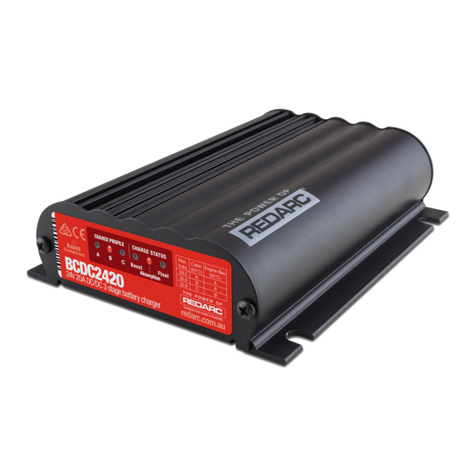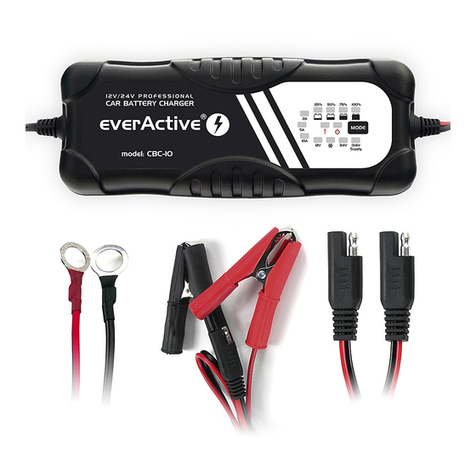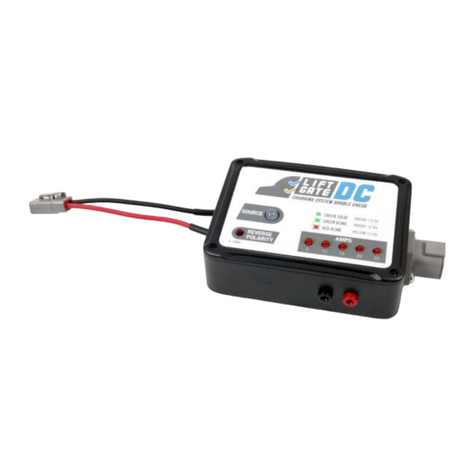Kohler PA-320741 User manual

Operation and
Installation Instructions
TT-855 12/93b
Automatic Battery Chargers
Kits:
PA-320741
through P
A-320764 and
P
A-320741-SD through P
A-320764-SD

iTT
-855 12/93
T
able of Contents
Table of Contents
SUBJECT PAGE SUBJECT PAGE
Safety Precautions and Instructions 1.
. . . . . . . . . .
Introduction 4
. . . . . . . . . . . . . . . . . . . . . . . . . . . . . . . . .
Specifications 5
. . . . . . . . . . . . . . . . . . . . . . . . . . . . . . .
Installing Charger 8.
. . . . . . . . . . . . . . . . . . . . . . . . . . .
Mount Charger 9.
. . . . . . . . . . . . . . . . . . . . . . . . . . . . .
Ouput Connections 9.
. . . . . . . . . . . . . . . . . . . . . . . . .
Input Connections 9.
. . . . . . . . . . . . . . . . . . . . . . . . . .
Disconnecting Charger 11.
. . . . . . . . . . . . . . . . . . . . .
Battery Charger Operation 12.
. . . . . . . . . . . . . . . . . .
Charging Lead-Acid Batteries 12.
. . . . . . . . . . . . . . .
Checking Specific Gravity 14.
. . . . . . . . . . . . . . . . . .
Charging Nickel-Cadmium Batteries 14.
. . . . . . . . .
Charger Voltage Adjustment 15.
. . . . . . . . . . . . . . . .
Charger and Battery Maintenance 15.
. . . . . . . . . . .
Troubleshooting 16
. . . . . . . . . . . . . . . . . . . . . . . . . . . .
Standard Accessories 17.
. . . . . . . . . . . . . . . . . . . . . .
Current Limiting 17.
. . . . . . . . . . . . . . . . . . . . . . . . . . .
Reverse Polarity Protection 17.
. . . . . . . . . . . . . . . . .
Automatic Float Operation 17.
. . . . . . . . . . . . . . . . . .
Temperature Compensation 17.
. . . . . . . . . . . . . . . .
AC Input Fuse 17.
. . . . . . . . . . . . . . . . . . . . . . . . . . . .
DC Output Fuse 17.
. . . . . . . . . . . . . . . . . . . . . . . . . .
Power On Lamp 17.
. . . . . . . . . . . . . . . . . . . . . . . . . .
Wiring Diagrams 18.
. . . . . . . . . . . . . . . . . . . . . . . . . . .
Parts Lists 24.
. . . . . . . . . . . . . . . . . . . . . . . . . . . . . . . . .

1TT
-855 12/93
Safety Precautions
Safety Precautions and Instructions
A generator set, like any other electro-mechanical
device, can pose potential dangers to life and limb if
improperly maintained or imprudently operated. The
best way to prevent accidents is to be aware of the
potential dangers and to always use good common
sense. In the interest of safety, some general
precautions
relating the to operating of a generator set
follow. Keep these in mind. This manual contains
several
types of safety precautions
which are explained
below.
DANGER
Danger is used to indicate the presence of a hazard that
will
cause
severe
personal injury, death, or substantial
property damage if the warning is ignored.
WARNING
Warning is used to indicate the presence of a hazard
that
can
cause
severe
personal injury, death, or
substantial property damage if the warning is ignored.
CAUTION
Caution
is
used to indicate the presence of a hazard that
will
or
can
cause
minor
personal injury or property
damage if the warning is ignored.
NOTE
Note
is used
to notify people of installation, operation, or
maintenance information that is important but not
hazard-related.
Safety decals are affixed to the generator set in
prominent places to advise the operator or service
technician of potentially hazardous situations. The
decals are reproduced here to improve operator
recognition and thereby increase decal effectiveness.
For
a further
explanation of decal information, reference
the accompanying safety precautions. Before
operating or servicing the generator set, be sure you
understand the message of these decals. Replace
decals if missing or damaged.
Accidental Starting
WARNING
Accidental starting.
Can cause severe injury or death.
Disconnect battery cables before working on
generator set (negative lead first and reconnect it
last).
Accidental starting can cause severe injury or
death. Turn generator master switch to OFF position,
disconnect power to battery charger, and remove
battery cables (remove negative lead first and
reconnect
it last) to disable generator set before working
on any equipment connected to generator. The
generator set can be started by automatic transfer
switch or remote start/stop switch unless these
precautions are followed.

2 TT
-855 12/93
Safety Precautions
Hazardous Voltage/Electrical Shock
WARNING
Hazardous voltage.
Do not operate generator set without all guards
and electrical enclosures in place.
Moving rotor.
Can cause severe injury or death.
Hazardous voltage can cause severe injury or
death.
De-energize both normal and emergency power
sources before proceeding. Move generator master
switch on controller to OFF position and disconnect
battery negative (–) before working on transfer switch!
Turn the transfer switch selector switch to the OFF
position.
Hazardous voltage can cause severe injury or
death. Keep everyone away from the set and take
precautions to prevent unqualified personnel from
tampering.
Have the set and electrical circuits serviced
only by qualified technicians. Wiring should be
inspected at the recommended interval shown in the
service schedule—replace leads that are frayed or in
poor condition. Do not operate electrical equipment
when standing in water, on wet ground, or when your
hands are wet.
Hazardous voltage can cause severe injury or
death. Electrical shock may occur if battery charger is
not properly grounded. Connect battery charger
enclosure
to ground of a permanent wiring
system. As
an alternative, run an equipment-grounding conductor
with circuit conductors and connect to
equipment-grounding terminal or lead on battery
charger. Battery charger installation should be
performed
as prescribed in equipment manual and must
comply with all local codes and ordinances.
(Applies to Optional Battery Charger.)
Hazardous voltage can cause severe injury or
death. Improper reconnection may damage charger
and
battery(ies), and
create an electrical shock hazard.
Installation must be done by a qualified electrician.
(Applies to Optional Battery Charger.)
Hazardous voltage can cause severe injury or
death. Short circuits can cause bodily injury and/or
equipment damage. Do not contact electrical
connections
with tools or jewelry while adjustments are
made.
Remove wristwatch, rings, and jewelry that can
cause short circuits.

3TT
-855 12/93
Safety Precautions
Battery
WARNING
Sulfuric acid in batteries.
Can cause severe injury or death.
Use protective goggles and clothes. Can cause
permanent
damage to eyes, burn skin, and eat holes
in clothing.
Sulfuric
acid in batteries
can cause severe injury or
death. Sulfuric acid in battery can cause permanent
damage to eyes, burn skin, and eat holes in clothing.
Always
wear splash-proof safety goggles when working
around the battery. If battery electrolyte
is splashed in
the
eyes or
on skin, immediately flush the af
fected area
for
15 minutes with large quantities of clean water
. In
the
case of eye contact, seek immediate medical aid. Never
add acid to a battery once
the
battery has been placed in
service.
Doing so may result in
hazardous spattering of
electrolyte.
Explosion can cause severe injury or death.
Battery
gases
can cause an explosion. Do not smoke or permit
flame or spark to occur near a battery at any time,
particularly
when it is being charged. A
void contacting
terminals
with tools,
etc. to prevent burns and to prevent
sparks that could cause an explosion. Remove
wristwatch,
rings, and any other jewelry before handling
battery. Never connect negative (–) battery cable to
positive (+) connection terminal of starter solenoid. Do
not
test battery condition by shorting terminals together
or sparks could ignite battery gases or fuel vapors. Any
compartment containing batteries must be well
ventilated to prevent accumulation of explosive gases.
To avoid sparks, do not disturb battery charger
connections
while battery is being charged and always
turn charger off before disconnecting battery
connections. When disconnecting battery, remove
negative lead first and reconnect it last.
NOTES
NOTE
Charge only LEAD-ACID or NICKEL-CADMIUM
batteries with battery charger.
NOTE
Split lock washers may be supplied with some kits. If
split lock washers are supplied with kit, their use is
optional.
(use with kits only)
NOTE
HARDWARE DAMAGE! Engine and generator may
make use of both American Standard and metric
hardware. Be sure to use the correct size tools to
prevent rounding of bolt heads and nuts.

4 TT
-855 12/93
Introduction
Introduction
This TT includes the following kits:
PA-320741 through P
A-320764 and
PA-320741-SD through PA-320764-SD
This manual contains important safety and operating
instructions for automatic 2-amp battery chargers.
Before using the battery charger, read all instructions
and cautionary instructions on (1) battery charger, (2)
battery, and (3) product using battery. Keep these
instructions
in mind when operating the battery charger
.
The battery chargers are designed for various AC
voltage,
50- or 60-Hz input, and capable of charging as
follows:
12-Volt Charger Lead-Acid Battery (6-cell)
24-Volt Charger Lead-Acid Battery (12-cell)
Determine input voltage and type of battery(ies) to be
charged. Make any necessary modifications before
using charger.
Grounding Instructions—Connect the battery
charger
to a
grounded, metal, permanent wiring system
or an equipment-grounding conductor with circuit
conductors and connect it to equipment-grounding
terminal or lead on battery charger. Connections to
battery charger should comply with all local codes and
ordinances.

5TT
-855 12/93
Specifications
Specifications
The automatic battery charger is designed to charge
and maintain lead-acid and nickel-cadmium
automotive-type batteries in a fully charged state
without any manual intervention. The charger output
provided by the power transformer is controlled by the
circuit board. The control board provides the charger
with current-limiting, AC line compensation,
reverse-polarity protection, ambient-temperature
compensation, and constant voltage charging mode.
The control circuit board continuously monitors the
battery and load conditions to maintain the battery’s
proper
state of charge. Refer to Figure 1 for component
identification. The chargers are factory adjusted to
maintain the battery at the proper float voltages. The
12-volt
charger will
maintain a lead-acid (6-cell) battery
with no adjustment required. The 24-volt charger will
maintain
a lead-acid (12-cell) battery with no adjustment
required.
A-294226-A
P1
294241-B
GRD
POWER
ON
AC + –
VOLT.
ADJ.
AC
AC INPUT
120V 50/60HZ .68A
DC OUTPUT
12V 2A
DC
OUTPUT
6A
AC
INPUT
1A
321
DC
AMPERES
0
1 2 3 4
5
678
1. DC
Ammeter
2.
DC Output Fuse
3.
“Power On” Lamp
4. Transformer
5.
Main Circuit Board Assembly
6.
AC Input Fuse
7. T
erminal Block
8.
Ground T
erminal (AC)
Figure 1. Battery Charger Components

6 TT
-855 12/93
Specifications
Battery Charger Kits Selection Table
e
led
Volts Input
V
oltage
Descriptions
Loos
e
Install
e
12 24
120 V
50/60 Hz
240 V
50/60 Hz
220 V
50/60 Hz
480/600 V
50/60 Hz
208 V
50/60 Hz
380/416 V
50/60 Hz
T
ransfer Switch Accessory No.
X X KA-24-62A KA-24-64A KA-24-63A KA-24-60A KA-24-68A KA-24-71A
Battery Charger Kit No. *
X X PA-320741 PA-320747 PA-320745 PA-320751 PA-320743 PA-320749
T
ransfer Switch Accessory No.
X X KA-24-62B KA-24-64B KA-24-63B KA-24-60B KA-24-68B KA-24-71B
Battery Charger Kit No. *
X X PA-320742 PA-320748 PA-320746 PA-320752 PA-320744 PA-320750
* SA
TS model transfer switches have an -SD suffix. EXAMPLE: P
A-320741-SD
Figure 2. Battery Chargers for S340 Model Transfer Switch
s
e
l
led
Volts Input
V
oltage
Descriptions
Loos
e
Install
12 24
120 V
50/60 Hz
240 V
50/60 Hz
220 V
50/60 Hz
480/600 V
50/60 Hz
208 V
50/60 Hz
380/416 V
50/60 Hz
T
ransfer Switch Accessory No.
X X DA-24-62A DA-24-64A DA-24-63A DA-24-60A DA-24-68A DA-24-71A
Battery Charger Kit No. *
X X PA-320741 PA-320747 PA-320745 PA-320751 PA-320743 PA-320749
T
ransfer Switch Accessory No.
X X DA-24-62B DA-24-64B DA-24-63B DA-24-60B DA-24-68B DA-24-71B
Battery Charger Kit No. *
X X PA-320742 PA-320748 PA-320746 PA-320752 PA-320744 PA-320750
* SA
TS+ model transfer switches have an -SD suf
fix. EXAMPLE: P
A-320741-SD
Figure 3. Battery Chargers for S340+ Model Transfer Switch
s
e
l
led
Volts Input
V
oltage
Descriptions
Loos
e
Install
12 24
120 V
50/60 Hz
240 V
50/60 Hz
220 V
50/60 Hz
480/600 V
50/60 Hz
208 V
50/60 Hz
380/416 V
50/60 Hz
T
ransfer Switch Accessory No.
X X KD-24-62A KD-24-64A KD-24-63A KD-24-60A KD-24-68A KD-24-71A
Battery Charger Kit No. *
X X PA-320753 PA-320759 PA-320757 PA-320763 PA-320755 PA-320755
T
ransfer Switch Accessory No.
X X KD-24-62B KD-24-64B KD-24-63B KD-24-60B KD-24-68B KD-24-71B
Battery Charger Kit No. *
X X PA-320754 PA-320760 PA-320758 PA-320764 PA-320756 PA-320756
* MA
TS model transfer switches have an -SD suffix. EXAMPLE: P
A-320741-SD
Figure 4. Battery Chargers for M340 Model Transfer Switch

7TT
-855 12/93
Specifications
e
led
Volts Input
V
oltage
Descriptions
Loos
e
Install
e
12 24
120 V
50/60 Hz
240 V
50/60 Hz
220 V
50/60 Hz
480/600 V
50/60 Hz
208 V
50/60 Hz
380/416 V
50/60 Hz
T
ransfer Switch Accessory No.
X X DD-24-62A DD-24-64A DD-24-63A DD-24-60A DD-24-68A DD-24-71A
Battery Charger Kit No. *
X X PA-320753 PA-320759 PA-320757 PA-320763 PA-320755 PA-320761
T
ransfer Switch Accessory No.
X X DD-24-62B DD-24-64B DD-24-63B DD-24-60B DD-24-68B DD-24-71B
Battery Charger Kit No. *
X X PA-320754 PA-320760 PA-320758 PA-320764 PA-320756 PA-320762
* MA
TS+ model transfer switches have an -SD suf
fix. EXAMPLE: P
A-320741-SD
Figure 5. Battery Chargers for M340+ Model Transfer Switch
s
e
l
led
Volts Input
V
oltage
Descriptions
Loos
e
Install
12 24
120 V
50/60 Hz
240 V
50/60 Hz
220 V
50/60 Hz
480/600 V
50/60 Hz
208 V
50/60 Hz
380/416 V
50/60 Hz
T
ransfer Switch Accessory No.
X X ––– KD-24-64A KD-24-63A ––– ––– –––
Battery Charger Kit No.
X X ––– ––– ––– ––– ––– –––
T
ransfer Switch Accessory No.
X X ––– KD-24-64B KD-24-63B ––– ––– –––
Battery Charger Kit No.
X X ––– ––– ––– ––– ––– –––
Figure 6. Battery Chargers for R33 Model Transfer Switch
Input
V
oltage
Descriptions
120 V
50/60 Hz
240 V
50/60 Hz
220 V
50/60 Hz 480/600 V
50/60 Hz 208 V
50/60 Hz
380/416 V
50/60 Hz
Primary Circuit
Protection
1 Amp 12 V
1.5 Amp 24 V 0.5 Amp 12 V
1 Amp 24 V
0.5 Amp 12 V
1 Amp 24 V
0.2 Amp 12 V
0.4 Amp 24 V 0.5 Amp 12 V
1 Amp 24 V
0.3 Amp 12 V
0.5 Amp 24 V
Secondary Circuit
Protection
6 Amp Slo-Blo
Output Level
Preset at Factory
12-V
olt Charger—13.2 V
olt, 2 Amp Current Limiting
24- V
olt Charger—26.4 V
olt, 2 Amp Current Limiting
Figure 7. Battery Charger Specifications

8 TT
-855 12/93
Installation
Installing Charger
WARNING
Sulfuric acid in batteries.
Can cause severe injury or death.
Use protective goggles and clothes. Can cause
permanent
damage to eyes, burn skin, and eat holes
in clothing.
Sulfuric
acid in batteries
can cause severe injury or
death. Sulfuric acid in battery can cause permanent
damage to eyes, burn skin, and eat holes in clothing.
Always
wear splash-proof safety goggles when working
around the battery. If battery electrolyte
is splashed in
the
eyes or
on skin, immediately flush the af
fected area
for
15 minutes with large quantities of clean water
. In
the
case of eye contact, seek immediate medical aid. Never
add acid to a battery once
the
battery has been placed in
service.
Doing so may result in
hazardous spattering of
electrolyte.
WARNING
Accidental starting.
Can cause severe injury or death.
Disconnect battery cables before working on
generator set (negative lead first and reconnect it
last).
Accidental starting can cause severe injury or
death. Turn generator master switch to OFF position,
disconnect power to battery charger, and remove
battery cables (remove negative lead first and
reconnect
it last) to disable generator set before working
on any equipment connected to generator. The
generator set can be started by automatic transfer
switch or remote start/stop switch unless these
precautions are followed.
NOTE
CHARGER
DAMAGE!
Connect battery
charger only to
a battery with the same DC voltage as the battery
charger output rating.
WARNING
Explosion.
Can cause severe injury or death. Relays in
battery charger cause arcs or sparks.
Locate in a well ventilated area. Keep explosive
fumes away.
Explosion
can cause severe injury or death.
Battery
gases
can cause an explosion. Do not smoke or permit
flame or spark to occur near a battery at any time,
particularly
when it is being charged. A
void contacting
terminals
with tools,
etc. to prevent burns and to prevent
sparks that could cause an explosion. Remove
wristwatch,
rings, and any other jewelry before handling
battery. Never connect negative (–) battery cable to
positive (+) connection terminal of starter solenoid. Do
not
test battery condition by shorting terminals together
or sparks could ignite battery gases or fuel vapors. Any
compartment containing batteries must be well
ventilated to prevent accumulation of explosive gases.
To avoid sparks, do not disturb battery charger
connections
while battery is being charged and always
turn charger off before disconnecting battery
connections. When disconnecting battery, remove
negative lead first and reconnect it last.

9TT
-855 12/93
Installation
Mount Charger
1. Move generator master switch to OFF position.
Disconnect battery cables, negative lead first.
Open circuit breaker of AC power source to be
applied.
2. Turn automatic transfer switch selector to OFF
position.
3. Open automatic transfer switch enclosure.
4. Install four captive nuts (298811) in the transfer
switch
inner panel and install battery charger
. See
Figure 8.
5. The battery charger is factory set to maintain the
proper
output for the battery voltage for which it is
rated. No customer adjustments are required.
Output Connections
NOTE
For
DC
connections use stranded copper wire, 600 V
olt,
105_C vinyl plastic insulation UL style 1015, CSA
type
TEW.
1. Due to the variety of generator installations,
battery cables are not provided. To make battery
connections, cut red (+) 10-gauge stranded wire
to proper length and strip insulation from both
ends. To one end of wire attach a post-type
connector. Route other end of battery cable and
connect
to output positive (+) terminal on
charger
DC terminal block. See
Figure 8. T
ighten terminal
block lock screw to secure battery cable. Repeat
procedure
with black (–) 10-gauge stranded wire;
connect black wire to output negative (–)
terminal
on DC terminal
block
and secure with lock screw
.
2. Connect
red charger lead(s) to battery positive
(+)
terminal and black charger lead(s) to battery
negative (–) terminal.
Grounding Instructions—This
battery charger should
be connected to a grounded, metal, permanent wiring
system.
An equipment-grounding conductor could
also
be run with circuit conductors and connected to
equipment-grounding terminal on battery charger.
Connections to battery charger should comply with all
local codes and ordinances.
Input Connections
1. Connect
the correct voltage, 50/60 Hz, AC power
source as indicated by nameplate or transfer
switch wiring diagram.
2. Turn AC power on. Power On lamp will light and
ammeter will show charging current.

10 TT
-855 12/93
Installation
BW-29500-B294241-B
1
2
1. Battery
Charger Assembly (see parts lists)
2.
Captive Nuts (29881
1) qty
. 4
Figure 8. Battery Charger Installation—Solid-State Transfer Switch

11TT
-855 12/93
Disconnection
Disconnecting Charger
(When Replacing or Servicing Battery)
WARNING
Explosion.
Can cause severe injury or death. Relays in
battery charger cause arcs or sparks.
Locate in a well ventilated area. Keep explosive
fumes away.
Explosion
can cause severe injury or death.
Battery
gases
can cause an explosion. Do not smoke or permit
flame or spark to occur near a battery at any time,
particularly
when it is being charged. A
void contacting
terminals
with tools,
etc. to prevent burns and to prevent
sparks that could cause an explosion. Remove
wristwatch,
rings, and any other jewelry before handling
battery. Never connect negative (–) battery cable to
positive (+) connection terminal of starter solenoid. Do
not
test battery condition by shorting terminals together
or sparks could ignite battery gases or fuel vapors. Any
compartment containing batteries must be well
ventilated to prevent accumulation of explosive gases.
To avoid sparks, do not disturb battery charger
connections
while battery is being charged and always
turn charger off before disconnecting battery
connections. When disconnecting battery, remove
negative lead first and reconnect it last.
WARNING
Sulfuric acid in batteries.
Can cause severe injury or death.
Use protective goggles and clothes. Can cause
permanent
damage to eyes, burn skin, and eat holes
in clothing.
Sulfuric
acid in batteries
can cause severe injury or
death. Sulfuric acid in battery can cause permanent
damage to eyes, burn skin, and eat holes in clothing.
Always
wear splash-proof safety goggles when working
around the battery. If battery electrolyte
is splashed in
the
eyes or
on skin, immediately flush the af
fected area
for
15 minutes with large quantities of clean water
. In
the
case of eye contact, seek immediate medical aid. Never
add acid to a battery once
the
battery has been placed in
service.
Doing so may result in
hazardous spattering of
electrolyte.
WARNING
Accidental starting.
Can cause severe injury or death.
Disconnect battery cables before working on
generator set (negative lead first and reconnect it
last).
Accidental starting can cause severe injury or
death. Turn generator master switch to OFF position,
disconnect power to battery charger, and remove
battery cables (remove negative lead first and
reconnect
it last) to disable generator set before working
on any equipment connected to generator. The
generator set can be started by automatic transfer
switch or remote start/stop switch unless these
precautions are followed.
1. Move generator master switch to OFF position.
2. Remove AC power supply from battery charger.
3. Remove charger connectors from battery,
negative lead first.

12 TT
-855 12/93
Operation
Battery Charger Operation
Charging Lead-Acid Batteries
WARNING
Sulfuric acid in batteries.
Can cause severe injury or death.
Use protective goggles and clothes. Can cause
permanent
damage to eyes, burn skin, and eat holes
in clothing.
Sulfuric
acid in batteries
can cause severe injury or
death. Sulfuric acid in battery can cause permanent
damage to eyes, burn skin, and eat holes in clothing.
Always
wear splash-proof safety goggles when working
around the battery. If battery electrolyte
is splashed in
the
eyes or
on skin, immediately flush the af
fected area
for
15 minutes with large quantities of clean water
. In
the
case of eye contact, seek immediate medical aid. Never
add acid to a battery once
the
battery has been placed in
service.
Doing so may result in
hazardous spattering of
electrolyte.
WARNING
Hazardous voltage.
Do not operate generator set without all guards
and electrical enclosures in place.
Moving rotor.
Can cause severe injury or death.
Hazardous voltage can cause severe injury or
death. Electrical shock may occur if battery charger is
not properly grounded. Connect battery charger
enclosure
to ground of a permanent wiring
system. As
an alternative, run an equipment-grounding conductor
with circuit conductors and connect to
equipment-grounding terminal or lead on battery
charger. Battery charger installation should be
performed
as prescribed in equipment manual and must
comply with all local codes and ordinances.
(Applies to Optional Battery Charger.)
WARNING
Explosion.
Can cause severe injury or death. Relays in
battery charger cause arcs or sparks.
Locate in a well ventilated area. Keep explosive
fumes away.
Explosion
can cause severe injury or death.
Battery
gases
can cause an explosion. Do not smoke or permit
flame or spark to occur near a battery at any time,
particularly
when it is being charged. A
void contacting
terminals
with tools,
etc. to prevent burns and to prevent
sparks that could cause an explosion. Remove
wristwatch,
rings, and any other jewelry before handling
battery. Never connect negative (–) battery cable to
positive (+) connection terminal of starter solenoid. Do
not
test battery condition by shorting terminals together
or sparks could ignite battery gases or fuel vapors. Any
compartment containing batteries must be well
ventilated to prevent accumulation of explosive gases.
To avoid sparks, do not disturb battery charger
connections
while battery is being charged and always
turn charger off before disconnecting battery
connections. When disconnecting battery, remove
negative lead first and reconnect it last.
Charge
6- or 12-cell lead-acid batteries according to the
following procedure.
1. Inspect battery for defective cables, loose posts,
or loose terminals. Battery terminals and battery
charger clips must be tight and cleaned of all
corrosion for efficient charging.
2. Check
the fluid level in each cell. If fluid
level is low
,
add
distilled water until fluid is at proper level. (No
maintenance is required for sealed batteries.)
When
using a dry-charge battery
, the battery must
be
given a conditioning charge immediately after
the
electrolyte fluid
has been added. An automatic
charger will not operate properly on this type of
battery unless it has been given a conditioning
charge. Follow the battery manufacturer’s
recommendations for length of charge.

13TT
-855 12/93
Operation
3. The charge rate the charger is delivering to the
battery
is indicated on the ammeter
. The charger
control circuit limits the maximum charging
current to 2 amps. No cranking disconnect is
required due to the current-limit protection
feature. A battery is almost fully charged when
one of the following occurs:
Charging
rate will taper to zero.
This occurs as
a
battery becomes charged and the battery voltage
approaches the control voltage setting. The
ammeter needle may fluctuate, indicating a
continuous supply of pulsating current that
automatically keeps the battery in a charged
condition.
Specific gravity reading (using a hydrometer)
should be between 1.250 and 1.285 at an
electrolyte temperature of 80_F (26.7_C). This
hydrometer reading indicates a battery that is in
good condition.
Bubbles appear at the surface of the battery
fluid. This indicates a battery that is 80 to 85%
charged. Vigorous bubbling occurs when the
battery is near full charge.
DAs
a battery becomes charged
and the battery
voltage approaches the control voltage
setting,
the charging rate will taper to zero. The
ammeter needle may fluctuate, indicating a
continuous supply of pulsating current that
automatically keeps the battery in a charged
condition.
DA battery in good condition should have a
specific gravity reading (using a hydrometer)
between 1.250 and 1.285 at an electrolyte
temperature
of 80
_
F (26.7
_
C). See “Checking
Specific Gravity.”
DWhen
a battery reaches 80-85% of full charge,
bubbles appear on the surface of fluid.
Vigorous bubbling occurs when the battery is
near full charge.

14 TT
-855 12/93
Operation
Checking Specific Gravity (Lead-Acid Batteries)
Use
a battery hydrometer to check the specific gravity of
the electrolyte in each battery cell. While holding the
hydrometer
vertically
, read the number on the glass bulb
at the top of the electrolyte level. The battery is fully
charged if the specific gravity is 1.260 at an electrolyte
temperature
of 80
_F (26.7_
C). The dif
ference between
specific gravities of each cell should not exceed 0.01.
The battery should be charged if the specific gravity is
below 1.215 at an electrolyte temperature of 80_F
(26.7_C).
The temperature of the battery electrolyte
will affect the specific gravity reading and
must be
taken into consideration when checking battery
specific gravity. If the hydrometer used does not
have a temperature correction table, use the one
shown in Figure 9.
10
20
30
40
50
60
70
80
90
100
110
120
130
140
150
160
12.2
6.7
1.1
4.4
10
21.1
26.7
32.2
37.8
43.3
48.9
54.4
60.0
65.6
71.1
15.6
+ .032
+ .030
+ .028
+ .026
+ .024
+ .022
+ .020
+ .018
+ .016
+ .014
+ .012
+ .010
+ .008
+ .006
+ .004
+ .002
0
.002
.004
. 006
.008
.010
.012
.014
.016
.018
.020
.022
.024
.026
.028
_C_F
EXAMPLE
NO
. 1
T
emperature below 80
_F
(26.7_C)
Hydrometer Reading 1.250
Acid T
emperature
20_
F (6.7
_C)
Subtract .024 Sp. Gravity
Corrected Sp. Gravity is 1.226
EXAMPLE NO
. 2
T
emperature above 80
_F
(26.7_C)
Hydrometer Reading 1.235
Acid T
emperature 100_F
(37.8_C)
Add .008 Sp. Gravity
Corrected Sp. Gravity is 1.243
The Temperature correction amounts to about .004 (4
“points”)
of specific gravity for each 10
_
F (5.5
_
C) change in
temperature.
Correction
Figure 9. Specific Gravity Temperature Correction
Charging Nickel-Cadmium Batteries
Since charging recommendations vary between
manufacturers of nickel-cadmium batteries, specific
nickel-cadmium battery charging instructions are not
provided
in this manual. Contact the manufacturer of
the
nickel-cadmium battery for specific charging and
maintenance instructions. If the voltage setting
recommended by the battery manufacturer is different
from the battery charger’s factory setting, call battery
charger manufacturer for the procedure for properly
adjusting the battery charger.

15TT
-855 12/93
Operation
Charger Voltage Adjustment
The
battery charger
’
s output settings are factory set and
normally
require no customer
adjustment. If adjustment
is
required, contact
an authorized distributor for service
or service literature. The factory settings are listed
below.
Factory Output Settings
Charger
Voltage Float
Voltage Current
Limit
12 V 13.2 V 2 A
24 V 26.4 V 2 A
Charger and Battery Maintenance
WARNING
Hazardous voltage.
Do not operate generator set without all guards
and electrical enclosures in place.
Moving rotor.
Can cause severe injury or death.
Hazardous voltage can cause severe injury or
death. Electrical shock may occur if battery charger is
not properly grounded. Connect battery charger
enclosure
to ground of a permanent wiring
system. As
an alternative, run an equipment-grounding conductor
with circuit conductors and connect to
equipment-grounding terminal or lead on battery
charger. Battery charger installation should be
performed
as prescribed in equipment manual and must
comply with all local codes and ordinances.
(Applies to Optional Battery Charger.)
Hazardous voltage can cause severe injury or
death. Improper reconnection may damage charger
and
battery(ies), and
create an electrical shock hazard.
Installation must be done by a qualified electrician.
(Applies to Optional Battery Charger.)
Hazardous voltage can cause severe injury or
death. Short circuits can cause bodily injury and/or
equipment damage. Do not contact electrical
connections
with tools or jewelry while adjustments are
made.
Remove wristwatch, rings, and jewelry that can
cause short circuits.
WARNING
Sulfuric acid in batteries.
Can cause severe injury or death.
Use protective goggles and clothes. Can cause
permanent
damage to eyes, burn skin, and eat holes
in clothing.
Sulfuric
acid in batteries
can cause severe injury or
death. Sulfuric acid in battery can cause permanent
damage to eyes, burn skin, and eat holes in clothing.
Always
wear splash-proof safety goggles when working
around the battery. If battery electrolyte
is splashed in
the
eyes or
on skin, immediately flush the af
fected area
for
15 minutes with large quantities of clean water
. In
the
case of eye contact, seek immediate medical aid. Never
add acid to a battery once
the
battery has been placed in
service.
Doing so may result in
hazardous spattering of
electrolyte.
NOTE
Warranty repairs must be made through an
authorized
dealer.
1. Check battery terminals and charger connectors
for clean contact surfaces. Clean battery
terminals and charger connectors as necessary
with a mild baking soda/water solution. If battery
charger does not work, see Troubleshooting
section.
2. Check battery fluid level regularly; maintain
battery fluid at proper level.

16 TT
-855 12/93
Troubleshooting
Troubleshooting
Problem Remedy
No Ammeter Reading 1. Check charger connections to battery for correct polarity.
2. Turn off AC supply prior to rechecking the battery charger for clean, tight
connections.
3. Check for AC at the charger terminal strip.
4. Check AC input and DC output fuses.
5. Check
secondary voltage at transformer: 24 volts across
secondary
, with 12
volts to center tap.
6. With AC supply disconnected, check DC output lead connections from
circuit board to DC output terminal block.
Needle Remains at 2 Amps
Indefinitely 1. Battery charger not matched to battery voltage.
2. Battery may be severely discharged or have shorted cells.

17TT
-855 12/93
Standard
Accessories
Standard Accessories
Current Limiting
The charger is protected from overload by its
current-limiting circuitry. This circuitry continuously
monitors
the charger output current and is set to limit the
current to 2 amps from full load to short circuit.
Therefore, no crank disconnect is required when the
plant is exercised.
Reverse Polarity Protection
When the charger is connected to the battery, the
reverse polarity protection circuit determines if the
connection is of the proper polarity. If the polarity is
incorrect,
the charger will not turn on when
AC input is
connected.
Automatic Float Operation
When the charger is properly connected to the battery
and AC power is applied to the charger, the charger
operates in the constant-current mode until the battery
voltage
rises to the preset float level. At the preset float
level, the charger will switch to the constant-voltage
float
mode. The charger will operate in constant-voltage
float mode until AC input power is lost or the current
required to maintain the battery at the float voltage
setting exceeds 2 amps.
Temperature Compensation
The charger will provide temperature compensation of
–2 mV/_
C per cell over the ambient temperature
range
of –40
_
C (–40
_
F) to +60
_
C (+140
_
F). This feature will
automatically adjust the float voltage setting
to
prevent
the battery from being overcharged at high ambient
temperatures and undercharged at low ambient
temperatures.
AC Input Fuse
When
AC input is applied, the AC input fuse will open to
protect the power transformer from damage due to a
short circuit condition. The fuse may also open if
subjected to vibration for an extended period of time.
Replace
the fuse to return the charger to operation. See
charts in “Specifications” section for fuse value.
DC Output Fuse
The DC output fuse will open and protect the power
transformer
from damage if the current limit setting
has
been
disabled or set to its maximum. It will also open if
the charger output leads are shorted together for an
extended period of time.
Power On Lamp
The Power On lamp is connected across the power
transformer’s primary winding and indicates when AC
power is present.

18 TT
-855 12/93
Wiring Diagrams
Wiring Diagrams
294262-A
SCHEMATIC
WIRING DIAGRAM
RED
WHT
GND.
AC INPUT
DC OUTPUT
6
AMP
BLK/
RED
BLK/
WHT
BLK
BLK /YEL
BLK
WHT
AC AC + –
BLK
POWER
ON
RED/BLUE
OR
RED/YELLOW
BLUE
RED
YEL
VIOLET
ORANGE ORANGE
DC
AB–
RED
ON
AC
CT
AC
YEL
B+
RED
AMMETER
TERMINAL
BLOCK
+
BLK
TRANSFORMER
DC
OUTPUT
6
AMP
AMMETER
AC
INPUT
1
AMP—12 V
TRANS.
–ACAC+
BLK/YEL
BLK/RED
WHT
BLK/WHT
BLK
RED
RED
BLK
CONTROL
BOARD
YEL
YEL
WHT
BLUE RED/BLUE OR RED/YELLOW
ORANGE
VIOLET
ORANGE
GND.
RED
POWER
ON
B–
B+
AC
CT
AC
ON
TERMINAL
BLOCK
CONTROL
BOARD
1.5
AMP—24 V
1
AMP—12 V
, 1.5
AMP—24 V
Figure 10. Wiring Diagram, Schematic—120-Volt Battery Charger
This manual suits for next models
43
Table of contents
Other Kohler Batteries Charger manuals
Popular Batteries Charger manuals by other brands

Muchmore
Muchmore cell master double accel MM-CTXDAK user manual
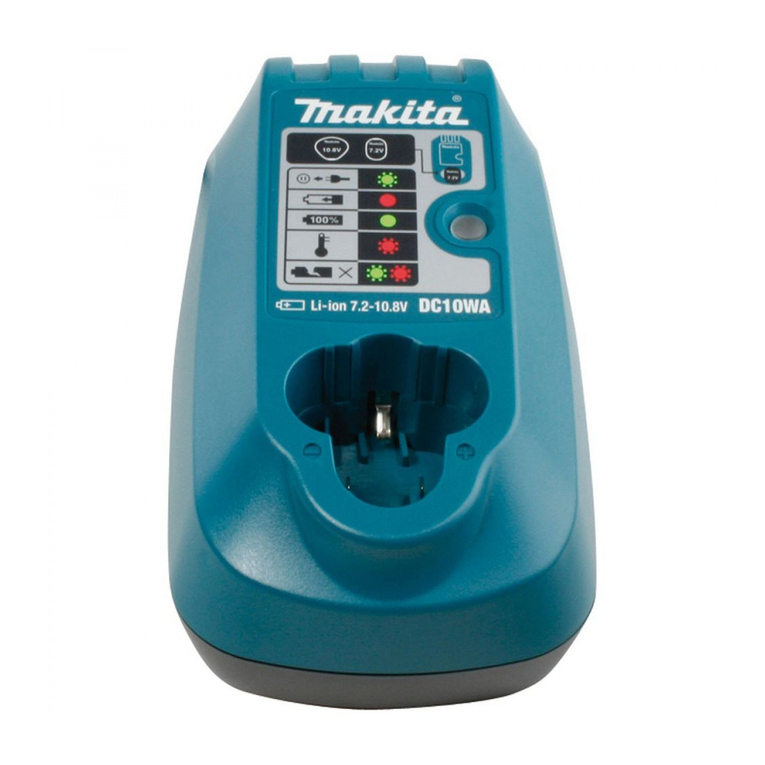
Makita
Makita DC10WA manual
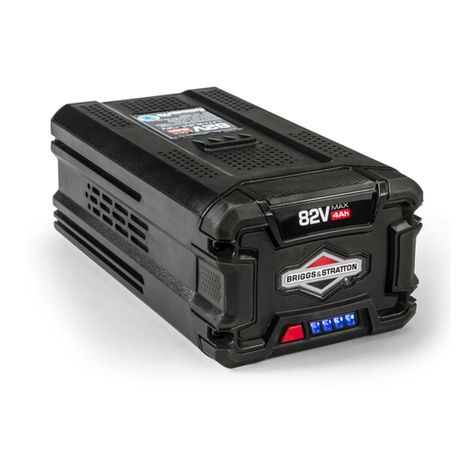
Briggs & Stratton
Briggs & Stratton BSB2AH82 owner's manual

Schumacher
Schumacher FARM & RANCH FR01336 owner's manual

Sterling Power Products
Sterling Power Products BB121250 Installation instructions manual
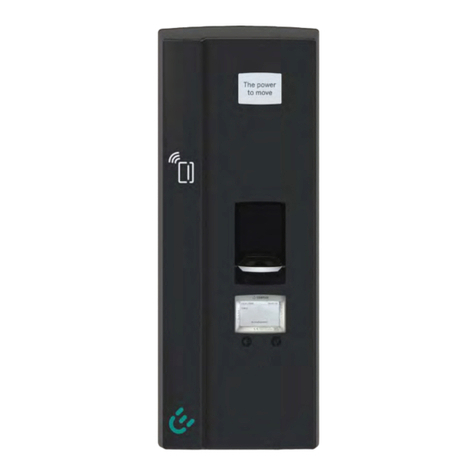
Compleo
Compleo SOLO smart operating instructions
